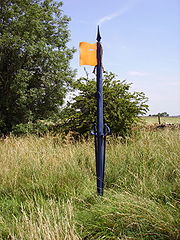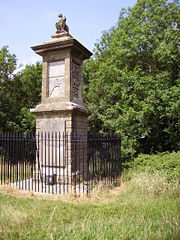
Battle of Lansdowne
Encyclopedia
The English Civil War
battle of Lansdowne (or Lansdown) was fought on 5 July 1643, near Bath, southwest England
. Although the Royalists
under Lord Hopton forced the Parliamentarians
under Sir William Waller
to retreat from their hilltop position, they suffered so many casualties themselves and were left so disordered and short of ammunition that an injured Hopton was forced to retire.
. On 3 July, skirmishes took place at Claverton
and at Waller's positions south and east of Bath. Waller retired to a strong position on Lansdown Hill, northwest of Bath while the main Royalist force moved north through Batheaston
to Marshfield
.
Hopton's forces encountered this position on 4 July and were unpleasantly surprised at its strength. They withdrew 5 miles (8 km) north-east to Marshfield, while their rearguard repulsed an attempt by Waller's cavalry to pursue. Early on 5 July, Waller moved to the north end of Lansdown Hill, where he built crude breastworks for his infantry, and sent some of his cavalry against Hopton's outposts. They put to flight some badly-led Royalist cavalry, and the alarm caused all of Hopton's army to form up and began advancing west, till they came in sight of Waller's position.
 There was indecisive skirmishing for two hours, and Hopton again tried to withdraw. Waller once again sent his horse and dragoons against the enemy rearguard, and this time they routed the Royalist cavalry, although the infantry stood firm. Hopton's army turned about, and defeated the Roundhead cavalry in a confused action. With his Cornish foot regiments already advancing without orders, Hopton at last attacked Lansdown Hill.
There was indecisive skirmishing for two hours, and Hopton again tried to withdraw. Waller once again sent his horse and dragoons against the enemy rearguard, and this time they routed the Royalist cavalry, although the infantry stood firm. Hopton's army turned about, and defeated the Roundhead cavalry in a confused action. With his Cornish foot regiments already advancing without orders, Hopton at last attacked Lansdown Hill.
As they charged up the steep slopes towards the Parliamentarian position on the crest, Hopton's cavalry suffered badly, and many panicked. 1,400 of them fled, some as far as Oxford. Under Sir Bevil Grenville
, Hopton's Cornish pikemen stormed Waller's breastworks, while Royalist musketeers outflanked Waller through the woods on each side of his position. Grenville was mortally wounded in hand-to-hand combat as Parliamentarian horse counter-attacked and were driven off. Waller's infantry fell back to a wall across the crest of the hill from where they kept up musket fire until dark fell. During the night, they withdrew silently, leaving burning matches on the wall to deceive the Royalists that they still held the position.
.
A Cornish officer describing the battle wrote that Waller was "... the best shifter and chooser of ground when hee was not Master of the field that ever I saw" (sic).
 The site of the battle is marked by a monument to Sir Bevil Grenville
The site of the battle is marked by a monument to Sir Bevil Grenville
, who died after the battle in Cold Ashton
Rectory.
English Civil War
The English Civil War was a series of armed conflicts and political machinations between Parliamentarians and Royalists...
battle of Lansdowne (or Lansdown) was fought on 5 July 1643, near Bath, southwest England
England
England is a country that is part of the United Kingdom. It shares land borders with Scotland to the north and Wales to the west; the Irish Sea is to the north west, the Celtic Sea to the south west, with the North Sea to the east and the English Channel to the south separating it from continental...
. Although the Royalists
Cavalier
Cavalier was the name used by Parliamentarians for a Royalist supporter of King Charles I and son Charles II during the English Civil War, the Interregnum, and the Restoration...
under Lord Hopton forced the Parliamentarians
Roundhead
"Roundhead" was the nickname given to the supporters of the Parliament during the English Civil War. Also known as Parliamentarians, they fought against King Charles I and his supporters, the Cavaliers , who claimed absolute power and the divine right of kings...
under Sir William Waller
William Waller
Sir William Waller was an English soldier during the English Civil War. He received his education at Magdalen Hall, Oxford, and served in the Venetian army and in the Thirty Years' War...
to retreat from their hilltop position, they suffered so many casualties themselves and were left so disordered and short of ammunition that an injured Hopton was forced to retire.
Campaign and Battle
By late May, 1643, Lord Hopton's royalist army had captured most of the south west of England. Joined by the Earl of Hertford, he now advanced eastward into Parliamentarian-held territory. Sir William Waller's army held Bath, to obstruct their further advance. On 2 July the Royalists seized the bridge at Bradford on AvonBradford on Avon
Bradford on Avon is a town in west Wiltshire, England with a population of about 9,326. The town's canal, historic buildings, shops, pubs and restaurants make it popular with tourists....
. On 3 July, skirmishes took place at Claverton
Claverton, Somerset
Claverton is a small village and civil parish about east of Bath at the southern end of the Cotswolds Area of Outstanding Natural Beauty, in Somerset, England...
and at Waller's positions south and east of Bath. Waller retired to a strong position on Lansdown Hill, northwest of Bath while the main Royalist force moved north through Batheaston
Batheaston
Batheaston is a village and civil parish east of Bath, England , on the north bank of the River Avon. The parish has a population of 2,625...
to Marshfield
Marshfield, Gloucestershire
Marshfield is a village in the local government area of South Gloucestershire, England, on the borders of the counties of Wiltshire and Somerset.- Location :...
.
Hopton's forces encountered this position on 4 July and were unpleasantly surprised at its strength. They withdrew 5 miles (8 km) north-east to Marshfield, while their rearguard repulsed an attempt by Waller's cavalry to pursue. Early on 5 July, Waller moved to the north end of Lansdown Hill, where he built crude breastworks for his infantry, and sent some of his cavalry against Hopton's outposts. They put to flight some badly-led Royalist cavalry, and the alarm caused all of Hopton's army to form up and began advancing west, till they came in sight of Waller's position.

As they charged up the steep slopes towards the Parliamentarian position on the crest, Hopton's cavalry suffered badly, and many panicked. 1,400 of them fled, some as far as Oxford. Under Sir Bevil Grenville
Bevil Grenville
Sir Bevil Grenville was an English politician who sat in the House of Commons of England between 1621 and 1642. He was a Royalist soldier in the English Civil War and was killed in action at the Battle of Lansdowne.-Backgound:...
, Hopton's Cornish pikemen stormed Waller's breastworks, while Royalist musketeers outflanked Waller through the woods on each side of his position. Grenville was mortally wounded in hand-to-hand combat as Parliamentarian horse counter-attacked and were driven off. Waller's infantry fell back to a wall across the crest of the hill from where they kept up musket fire until dark fell. During the night, they withdrew silently, leaving burning matches on the wall to deceive the Royalists that they still held the position.
Aftermath
The day after the battle, a Royalist ammunition cart exploded. Hopton was injured and temporarily blinded. The loss of the powder and the absence of most of their horse meant the Royalists could not fight another action. Meanwhile, Waller had retired to Bath, where he had been reinforced and was ready to attack again. Hopton's army retreated in low spirits to DevizesDevizes
Devizes is a market town and civil parish in Wiltshire, England. The town is about southeast of Chippenham and about east of Trowbridge.Devizes serves as a centre for banks, solicitors and shops, with a large open market place where a market is held once a week...
.
A Cornish officer describing the battle wrote that Waller was "... the best shifter and chooser of ground when hee was not Master of the field that ever I saw" (sic).

Sir Bevil Grenville's Monument
Sir Bevil Grenville's Monument is a monument erected on Lansdowne Hill, Bath, England, to commemorate the heroism of Sir Bevil Grenville and his Cornish pikemen at the Battle of Lansdowne, 1643...
, who died after the battle in Cold Ashton
Cold Ashton
Cold Ashton is a village in South Gloucestershire, England. The village church has a 14th century tower and the rest of the church was rebuilt in the 16th century by Thomas Key, its rector....
Rectory.
Sources
- Colonel H.C.B. Rodgers, Battles and Generals of the Civil Wars, Seeley Service & Co. Ltd, 1968, 327 pages. Hardback.

